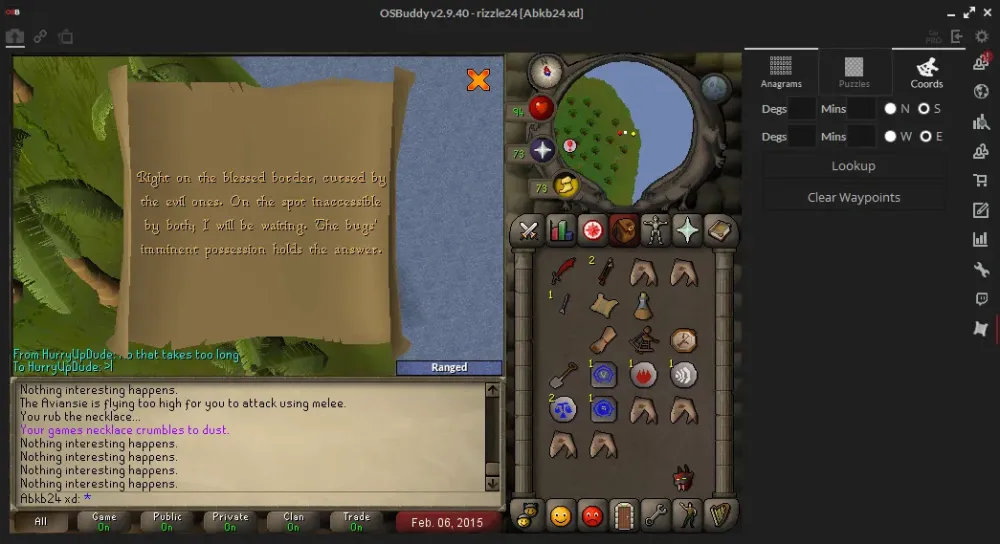Your cart is empty
OSRS Multiple Clue Scrolls Guide for Efficient Treasure Trails

Old School RuneScape (OSRS) Treasure Trails are a thrilling way to explore Gielinor, solve puzzles, and earn unique rewards. Clue scrolls, the heart of this activity, come in six difficulty levels: beginner, easy, medium, hard, elite, and master. A key mechanic that many players overlook is the ability to hold and manage multiple clue scrolls simultaneously, which can significantly boost efficiency and rewards. This guide dives into how to handle multiple clue scrolls, optimize your Treasure Trails, and maximize your gains, all while keeping your gameplay smooth and enjoyable.
Clue scrolls are random drops from monsters, minigames, or activities like fishing, woodcutting, or mining. They kick off Treasure Trails, sending players on a hunt across the game world to solve riddles, complete challenges, or dig for treasure. Each scroll has a specific difficulty, and the higher the tier, the better the potential rewards.
Types of Clue Scrolls
OSRS features six clue scroll difficulties, each with unique characteristics:
- Beginner: Free-to-play, simple steps, ideal for new players.
- Easy: Short trails, accessible to low-level players, with modest rewards.
- Medium: Moderate complexity, often requiring specific quests or skills.
- Hard: More challenging, with valuable rewards like rare cosmetics.
- Elite: High skill and quest requirements, offering high-value loot.
- Master: The toughest, with 6–8 steps and exclusive rewards like the scroll sack.
Why Hold Multiple Clue Scrolls?
Holding multiple clue scrolls allows you to batch-process Treasure Trails, saving time on gathering scrolls and optimizing your routes. Since you can carry one scroll of each difficulty at a time, you can strategically collect and complete them in bulk, especially for lower-tier scrolls that stack in your bank.
How to Obtain Multiple Clue Scrolls

Getting multiple clue scrolls requires understanding their drop mechanics and targeting the right activities. Here’s how to stock up efficiently.
Farming Clue Scrolls from Monsters
Most clue scrolls drop from monsters, with specific enemies tied to each difficulty. For example:
- Beginner: Goblins, barbarians, or baby implings.
- Easy: Guards, thugs, or young implings.
- Medium: Pyrefiends, ice warriors, or clue bottles from fishing.
- Hard: Hellhounds, greater demons, or clue geodes from mining.
- Elite: Rune dragons, Cerberus, or clue nests from woodcutting.
- Master: High-level bosses like Zulrah or Vorkath.
Focus on monsters with high drop rates, like hellhounds for hard clues, and use a looting bag in the Wilderness to collect drops faster.
Alternative Sources
Besides monster drops, you can get clue scrolls from:
- Minigames: Activities like Barbarian Assault or Castle Wars occasionally yield clues.
- Skilling: Fishing, mining, or woodcutting can drop clue bottles, geodes, or nests.
- Implings: Catching implings in Puro-Puro or across Gielinor is a fast way to gather scrolls, especially easy and medium ones.
Managing Multiple Clue Scrolls
Holding one clue scroll per difficulty means you can have up to six at once. However, managing them effectively requires strategy to avoid losing scrolls or wasting time.
Banking and Stacking
Since the 2015 update, clue scrolls of the same difficulty stack in your bank if you have one active in your inventory. This allows you to collect multiple scrolls without completing them immediately. For example, you can farm easy clues from guards, bank them, and complete them in bulk later.
Protecting Clue Scrolls
Clue scrolls are untradeable and usually retained on death outside the Wilderness. However, in the Wilderness (level 20+), an unprotected scroll or casket will disappear unless safeguarded by a clue box. Always carry a clue box for high-value scrolls, and equip items like the Wilderness sword or Royal Seed Pod, which are lost on death but easily replaced.
Handling Scrolls on the Ground
If you drop a clue scroll or leave it on the ground, you can still receive additional scrolls of the same difficulty. This allows you to alternate steps between two scrolls of the same tier, though it’s risky due to potential server disconnects or other players picking up your scroll in multi-combat areas.
Strategies for Completing Multiple Clue Scrolls
Completing multiple clue scrolls efficiently involves preparation, route optimization, and the right gear. Here’s how to streamline your Treasure Trails.
Preparation and Gear Setup
Before starting, ensure you have:
- Teleports: Access to fairy rings, spirit trees, jewelry (e.g., Ring of Dueling, Amulet of Glory), and teleports like Xeric’s Talisman or Ectophial.
- Skill Requirements: Check quest and skill prerequisites for your clue tier (e.g., 70 Agility for some elite clues).
- Inventory: Carry a spade, clue box, and teleports, leaving space for caskets and items needed for specific steps.
For Wilderness steps, wear cheap gear (e.g., monk robes) and bring only essentials to minimize risk.
Batching Clue Scrolls
Complete scrolls of the same difficulty in batches to save time. For example, gather 10 easy clue scrolls, then complete them in one session. Use a teleport-heavy setup to zip between locations, and prioritize steps that cluster in areas like Falador or Varrock.
Optimizing Routes
Plan your routes based on clue requirements. For example, if multiple clues require you to visit the Ardougne Monastery, do those steps consecutively. Tools like the OSRS Wiki or Alt1 Toolkit can help solve puzzles and map out locations quickly.
Rewards and Efficiency Tips
The rewards from Treasure Trails make managing multiple clue scrolls worthwhile, but efficiency is key to maximizing your loot.
Reward Tiers and Value
Each clue scroll difficulty offers unique rewards, with higher tiers yielding rarer items. Here’s a breakdown:
| Difficulty | Steps | Notable Rewards | Average Value |
|---|---|---|---|
| Beginner | 1–3 | Firelighters, god pages | 5k–20k GP |
| Easy | 3–5 | Black armor trim, biscuits | 10k–50k GP |
| Medium | 4–6 | Ranger boots, wizard boots | 50k–200k GP |
| Hard | 5–7 | 3rd age armor, gilded armor | 100k–1M GP |
| Elite | 5–7 | Dragon mask, ornate armor | 500k–5M GP |
| Master | 6–8 | Bloodhound pet, scroll sack | 1M–10M+ GP |
Stacking caskets (enabled since the 2015 update) lets you open multiple rewards at once, making it easier to track loot and sell items on the Grand Exchange.
Tips for Maximum Efficiency
To get the most out of your clue scrolls:
- Use Plugins: RuneLite plugins like the Clue Scroll Helper highlight steps and solutions, saving time on puzzles.
- Focus on High-Value Tiers: Hard, elite, and master clues offer the best rewards, so prioritize farming these if you have the skills and gear.
- Avoid Peak Hours: Complete Wilderness steps during off-peak server times to reduce PKer encounters.
- Track Progress: Use TempleOSRS or other trackers to monitor your clue completions and loot, especially for long-term goals like the scroll sack (100 master clues).
Common Pitfalls to Avoid
Watch out for these mistakes:
- Overloading Inventory: Don’t carry too many items, as some clues require specific gear or emotes.
- Ignoring Requirements: Check quest or skill prerequisites before starting elite or master clues to avoid getting stuck.
- Risking Scrolls: Always use a clue box in the Wilderness, and avoid carrying multiple caskets without banking them.
Managing multiple clue scrolls in OSRS is a game-changer for Treasure Trails enthusiasts. By farming scrolls efficiently, batching completions, and using the right tools, you can turn this activity into a profitable and fun adventure. Whether you’re chasing 3rd age armor or just enjoying the puzzles, this guide should help you navigate the world of clue scrolls with confidence. Grab your spade, stock up on teleports, and start hunting!
